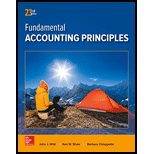
Concept explainers
Accounts receivable are the assets of the company as they depict the amount to be received in future from the customers to whom the products of the company have been sold. And thus, it can be described as the potential asset addition sources hence an asset for the company.
Bad debts can be described as that value of accounts receivable which are regarded by the companies as no more collectible or the potential customers who were liable to make such payments are not in situation to do so. Hence, bad debts are a loss and thus it ultimately decreases the assets of the company.
1.
To determine: The required balance of the allowance for doubtful accounts at December 31, 2017 using the aging of accounts receivable method.
To prepare:
Effect on net income in 2018.
Want to see the full answer?
Check out a sample textbook solution
Chapter 9 Solutions
Fundamental Accounting Principles
- I don't need ai answer general accounting questionarrow_forwardTotal costs were $81,300 when 33,000 units were produced and $102,500 when 42,000 units were produced. Use the High-Low Method to find the estimated total costs for a production level of 35,000 units.arrow_forwardGeneral Accounting MCQarrow_forward
- Honda Company had sales of $165,000, sales discounts of $4,200, and sales returns of $5,300. Honda Company's net sales equal: A. $172,500 B. $165,000 C. $155,500 D. $9,500 E. $160,800arrow_forwardDuring March, Avalon Electronics sold 300 smartwatches for $250 each. Each smartwatch had cost Avalon $120 to manufacture and comes with a one-year warranty. If 6% of the smartwatches typically need to be replaced over the warranty period, and fifteen are actually replaced during March, for what amount in March should Avalon debit Product Warranty Expense?arrow_forwardNeed helparrow_forward
- please post this question in Account tutors feedarrow_forwardAmish Company applies manufacturing overhead to jobs on the basis of machine hours used. Overhead costs are expected to total $276,660 for the year, and machine usage is estimated at 125,300 hours. For the year, $296,534 of overhead costs are incurred and 132,300 hours are used. Compute the manufacturing overhead rate for the year.Need Answerarrow_forwardA company has current assets with a book value of $50 million, which could be sold for $52 million. The company's fixed assets have a book value of $120 million, but they could be sold for $150 million today. The company has total debt with a book value of $80 million, but due to declining interest rates, the market value of the debt has increased to $90 million. What is the ratio of the market value of equity to its book value? (Round to 2 decimal places)arrow_forward

 AccountingAccountingISBN:9781337272094Author:WARREN, Carl S., Reeve, James M., Duchac, Jonathan E.Publisher:Cengage Learning,
AccountingAccountingISBN:9781337272094Author:WARREN, Carl S., Reeve, James M., Duchac, Jonathan E.Publisher:Cengage Learning, Accounting Information SystemsAccountingISBN:9781337619202Author:Hall, James A.Publisher:Cengage Learning,
Accounting Information SystemsAccountingISBN:9781337619202Author:Hall, James A.Publisher:Cengage Learning, Horngren's Cost Accounting: A Managerial Emphasis...AccountingISBN:9780134475585Author:Srikant M. Datar, Madhav V. RajanPublisher:PEARSON
Horngren's Cost Accounting: A Managerial Emphasis...AccountingISBN:9780134475585Author:Srikant M. Datar, Madhav V. RajanPublisher:PEARSON Intermediate AccountingAccountingISBN:9781259722660Author:J. David Spiceland, Mark W. Nelson, Wayne M ThomasPublisher:McGraw-Hill Education
Intermediate AccountingAccountingISBN:9781259722660Author:J. David Spiceland, Mark W. Nelson, Wayne M ThomasPublisher:McGraw-Hill Education Financial and Managerial AccountingAccountingISBN:9781259726705Author:John J Wild, Ken W. Shaw, Barbara Chiappetta Fundamental Accounting PrinciplesPublisher:McGraw-Hill Education
Financial and Managerial AccountingAccountingISBN:9781259726705Author:John J Wild, Ken W. Shaw, Barbara Chiappetta Fundamental Accounting PrinciplesPublisher:McGraw-Hill Education





